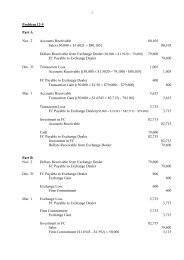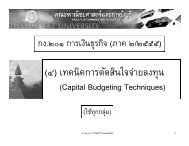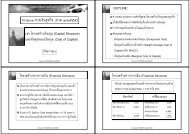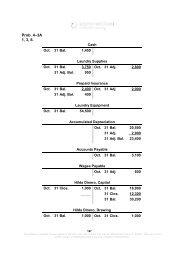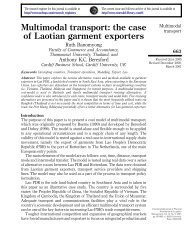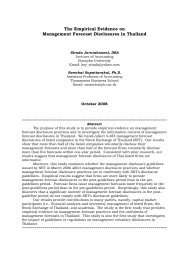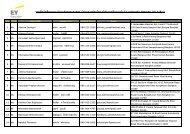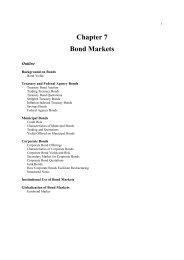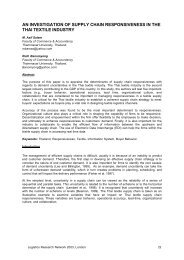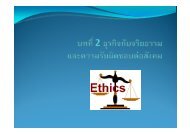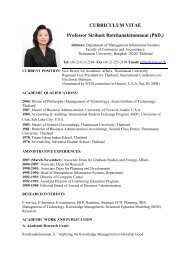Human capital and performance: A literature review
Human capital and performance: A literature review
Human capital and performance: A literature review
Create successful ePaper yourself
Turn your PDF publications into a flip-book with our unique Google optimized e-Paper software.
commitment <strong>and</strong> responsibility, shared values <strong>and</strong> vision. Without these virtues, a new paradigm of<br />
competitiveness, which rests on the individual <strong>and</strong> collective creativity <strong>and</strong> innovation, learning <strong>and</strong><br />
knowledge, skills <strong>and</strong> capabilities of the organization’s members, cannot be effectively realized.<br />
Robinson, G. & Kleiner, B. H. (1996). How to measure an organization’s intellectual <strong>capital</strong>.<br />
Managerial Auditing Journal, 11 (8), pp. 36-39.<br />
The authors propose some measurement valuation techniques of intellectual <strong>capital</strong>, which are the<br />
generic framework of value chain <strong>and</strong> the financial cash-flow valuation. The value of intellectual<br />
<strong>capital</strong> needs to be measured <strong>and</strong> appreciated to help determine the corporate objectives <strong>and</strong> strategies.<br />
As such, the individual know-how, skills <strong>and</strong> information systems are the key components in<br />
propelling the analysis of the intellectual <strong>capital</strong> creation.<br />
Stewart, T. A. (1999). Intellectual <strong>capital</strong>: the new wealth of organizations. London: Nicholas<br />
Brealey.<br />
The book provides a groundbreaking visionary evolution of intellectual <strong>capital</strong>, ranging from its origin<br />
to its powerful impact to the organizations. The principal contribution embarks on the practicality of<br />
the intellectual <strong>capital</strong> in leveraging the value of the firm <strong>and</strong> the wealth of the economy as a whole.<br />
The author starts off with describing the importance of intellectual <strong>capital</strong> <strong>and</strong> identifying where it is<br />
embedded. Then he moves on to the realization that human <strong>capital</strong> is a key driver to enabling the<br />
intellectual <strong>capital</strong> to be <strong>capital</strong>ized <strong>and</strong> delivered, thereby yielding innovation <strong>and</strong> growth. Another<br />
key driver is structural <strong>capital</strong>. It comprises the elements of strategy <strong>and</strong> culture, structures <strong>and</strong><br />
systems, organizational routines <strong>and</strong> procedures. It essentially provides an infrastructure to facilitate<br />
the power of intellectual <strong>capital</strong> or the stocks of knowledge within the firm. The last construct<br />
discussed in the book is customer <strong>capital</strong>, which refers to the relationship between employees of the<br />
firms <strong>and</strong> customers. All in all, human, structural, <strong>and</strong> customer <strong>capital</strong> have to work h<strong>and</strong>-in-h<strong>and</strong> to<br />
ensure the rigor of the intellectual <strong>capital</strong>.<br />
Ulrich, D. (1998). Intellectual <strong>capital</strong> = competence x commitment. MIT Sloan Management<br />
Review, 39 (2) Winter, pp. 15-26.<br />
The article highlights the missing focus of intellectual <strong>capital</strong>, which is a relationship founded on the<br />
commitment <strong>and</strong> competence of employees. Both must exist together for intellectual <strong>capital</strong> to grow.<br />
Tools for increasing competence <strong>and</strong> fostering commitment are presented to provide some practical<br />
implications to the managers. The authors conclude that leaders interested in investing, leveraging,<br />
<strong>and</strong> exp<strong>and</strong>ing intellectual <strong>capital</strong> should raise st<strong>and</strong>ards, set high expectations, <strong>and</strong> dem<strong>and</strong> more of<br />
employees. They must also provide resources to help employees meet high dem<strong>and</strong>s. Employees will<br />
become engaged <strong>and</strong> flourish, <strong>and</strong> the organization’s intellectual <strong>capital</strong> will turn into its defining<br />
asset.<br />
Williams, R. L. & Bukowitz, W. R. (2001). The yin <strong>and</strong> yang of intellectual <strong>capital</strong> management:<br />
the impact of ownership on realizing value from intellectual <strong>capital</strong>. Journal of Intellectual<br />
Capital, 2 (2), pp. 96-108.<br />
By exploring the nascent trend of business methods patenting in both the US <strong>and</strong> Europe, the authors<br />
make an emphasis on how awareness of the legal protection of the intangible asset has paved its way<br />
to the discussion of general business principles <strong>and</strong> to examine arguments for <strong>and</strong> against business<br />
methods patenting from both a public policy <strong>and</strong> a business perspective. A set of considerations for the<br />
firms to concern in pursuit of business methods patenting is provided to maximize the value of<br />
innovation <strong>and</strong> intellectual <strong>capital</strong>.<br />
<strong>Human</strong> <strong>capital</strong> <strong>and</strong> <strong>performance</strong> 39



